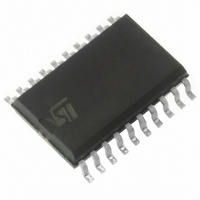L297D STMicroelectronics, L297D Datasheet - Page 4

L297D
Manufacturer Part Number
L297D
Description
IC STEPPER MOTOR CTRLR 20-SOIC
Manufacturer
STMicroelectronics
Type
Stepper Motor Controller/Driverr
Specifications of L297D
Applications
Stepper Motor Controller
Number Of Outputs
4
Voltage - Supply
4.75 V ~ 7 V
Operating Temperature
-40°C ~ 150°C
Mounting Type
Surface Mount
Package / Case
20-SOIC (7.5mm Width)
Product
Stepper Motor Controllers / Drivers
Operating Supply Voltage
7 V
Supply Current
80 mA
Mounting Style
SMD/SMT
Current, Input, High Level
10 uA (Max.)
Current, Input, Low Level
100 uA (Typ.)
Number Of Pins
20
Package Type
SO20
Power Dissipation
1 W (Max.)
Temperature, Operating, Maximum
150 °C
Temperature, Operating, Minimum
-40 °C
Voltage, Input
7 V (Max.)
Voltage, Input, High Level
2.0 V (Min.)
Voltage, Input, Low Level
0.6 V (Max.)
Voltage, Output, High Level
3.9 V (Min.)
Voltage, Output, Low Level
0.4 V (Max.)
Voltage, Supply
7 V (Max.)
Lead Free Status / RoHS Status
Lead free / RoHS Compliant
Current - Output
-
Voltage - Load
-
Lead Free Status / Rohs Status
Lead free / RoHS Compliant
Other names
497-1393-5
497-1393-5
497-3623
497-3623-5
497-1393-5
497-3623
497-3623-5
Available stocks
Company
Part Number
Manufacturer
Quantity
Price
Company:
Part Number:
L297D
Manufacturer:
STMicroelectronics
Quantity:
356
Company:
Part Number:
L297D
Manufacturer:
DENSO
Quantity:
6 235
Part Number:
L297D
Manufacturer:
ST
Quantity:
20 000
Part Number:
L297D013TR
Manufacturer:
ST
Quantity:
20 000
PIN FUNCTIONS - L297/1 - L297D (continued)
L297
THERMAL DATA
CIRCUIT OPERATION
The L297 is intended for use with a dual bridge
driver, quad darlington array or discrete power
devices in step motor driving applications. It re-
ceives step clock, direction and mode signals from
the systems controller (usually a microcomputer
chip) and generates control signals for the power
stage.
The principal functions are a translator, which gen-
erates the motor phase sequences, and a dual
PWM chopper circuit which regulates the current in
the motor windings. The translator generates three
different sequences, selected by the HALF/FULL
input. These are normal (two phases energised),
wave drive (one phase energised) and half-step
(alternately one phase energised/two phases en-
ergised). Two inhibit signals are also generated by
the L297 in half step and wave drive modes. These
signals, which connect directly to the L298’s enable
inputs, are intended to speed current decay when
a winding is de-energised. When the L297 is used
to drive a unipolar motor the chopper acts on these
lines.
An input called CONTROL determines whether the
chopper will act on the phase lines ABCD or the
inhibit lines INH1 and INH2. When the phase lines
4/11
N
19
20
Symbol
R
th-j-amb
Thermal resistance junction-ambient
HALF/FULL
RESET
NAME
Parameter
Half/full step select input. When high selects half step operation,
when low selects full step operation. One-phase-on full step mode
is obtained by selecting FULL when the L297’s translator is at an
even-numbered state.
Two-phase-on full step mode is set by selecting FULL when the
translator is at an odd numbered position. (The home position is
designate state 1).
Reset input. An active low pulse on this input restores the
translator to the home position (state 1, ABCD = 0101).
are chopped the non-active phase line of each pair
(AB or CD) is activated (rather than interrupting the
line then active). In L297 + L298 configurations this
technique reduces dissipation in the load current
sense resistors.
A common on-chip oscillator drives the dual chop-
per. It supplies pulses at the chopper rate which set
the two flip-flops FF1 and FF2. When the current in
a winding reaches the programmed peak value the
voltage across the sense resistor (connected to
one of the sense inputs SENS
V
flip flop, interrupting the drive current until the next
oscillator pulse arrives. The peak current for both
windings is programmed by a voltage divider on the
V
Ground noise problems in multiple configurations
can be avoided by synchronising the chopper os-
cillators. This is done by connecting all the SYNC
pins together, mounting the oscillator RC network
on one device only and grounding the OSC pin on
all other devices.
ref
ref
input.
and the corresponding comparator resets its
FUNCTION
max
DIP20
80
1
or SENS
SO20
100
2
) equals
Unit
C/W














